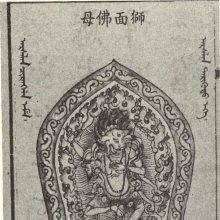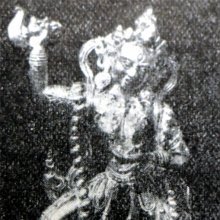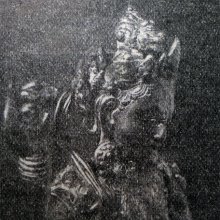Simhavaktra, Siṃhavaktra, Siṃhavaktrā, Simha-vaktra: 6 definitions
Introduction:
Simhavaktra means something in Buddhism, Pali, Hinduism, Sanskrit. If you want to know the exact meaning, history, etymology or English translation of this term then check out the descriptions on this page. Add your comment or reference to a book if you want to contribute to this summary article.
Images (photo gallery)
In Hinduism
Vastushastra (architecture)
Source: Wisdom Library: Vāstu-śāstraSiṃhavaktra (सिंहवक्त्र) refers to one of the four classes of praṇālas (“water-drains”) constructed into the sanctum for the purpose of draining oblation water and rainwater. It is a Sanskrit technical term used throughout Vāstuśāstra literature. The siṃhavaktra-praṇāla is connected with the Kṣatriya caste. It is also known as Siṃhāsya.
Source: Shodhganga: Temples of Salem region Up to 1336 ADSiṃhavaktra (सिंहवक्त्र).—A type of praṇāla, or ‘water-drain’.—Praṇālas having the decoration of the face of a lion is called siṃhavaktra or siṃhāsya. All the praṇālas of this type have the siṃhavaktra at the beginning of the exposed shaft. The tip of the shaft is bent and it terminates like a blossomed lotus flower. All these praṇālas are monolithic. These praṇālas have exposed ambumārgas throughout its length. Therefore the face is sometimes relieved on the two sides of the shafts. Globular eyes, pronounced nostrils, the upper jaw and the manes of the lion are all carved distinctly. In the carving of the shaft of the praṇāla, sometimes, the surface is made multifaceted, sometimes even ribbed, grooved and ridged.

Vastushastra (वास्तुशास्त्र, vāstuśāstra) refers to the ancient Indian science (shastra) of architecture (vastu), dealing with topics such architecture, sculpture, town-building, fort building and various other constructions. Vastu also deals with the philosophy of the architectural relation with the cosmic universe.
Purana and Itihasa (epic history)
Source: JatLand: List of Mahabharata people and placesSiṃhavaktra (सिंहवक्त्र) is a name mentioned in the Mahābhārata (cf. IX.44.78) and represents one of the many proper names used for people and places. Note: The Mahābhārata (mentioning Siṃhavaktra) is a Sanskrit epic poem consisting of 100,000 ślokas (metrical verses) and is over 2000 years old.

The Purana (पुराण, purāṇas) refers to Sanskrit literature preserving ancient India’s vast cultural history, including historical legends, religious ceremonies, various arts and sciences. The eighteen mahapuranas total over 400,000 shlokas (metrical couplets) and date to at least several centuries BCE.
In Buddhism
Tibetan Buddhism (Vajrayana or tantric Buddhism)
Source: archive.org: The Indian Buddhist IconographySiṃhavaktrā (सिंहवक्त्रा) is another name for Siṃhāsyā: one of the four “Animal-faced Goddess”, as commonly depicted in Buddhist Iconography, and mentioned in the 11th-century Niṣpannayogāvalī of Mahāpaṇḍita Abhayākara.—Her Colour is reddish-blue; her Symbol is the lion-face; she has two arms.—The fourth and the last deity in the series is called Siṃhāsyā (“lion-faced”) in the nairātmā-maṇḍala. [...] Under the title of Siṃhavaktrā she appears in the Chinese collection at Peiping.

Tibetan Buddhism includes schools such as Nyingma, Kadampa, Kagyu and Gelug. Their primary canon of literature is divided in two broad categories: The Kangyur, which consists of Buddha’s words, and the Tengyur, which includes commentaries from various sources. Esotericism and tantra techniques (vajrayāna) are collected indepently.
Languages of India and abroad
Sanskrit dictionary
Source: Cologne Digital Sanskrit Dictionaries: Monier-Williams Sanskrit-English Dictionary1) Siṃhavaktra (सिंहवक्त्र):—[=siṃha-vaktra] [from siṃha] m. Name of a Rākṣasa, [Rāmāyaṇa]
2) [v.s. ...] n. a lion’s face, [Catalogue(s)]
3) [v.s. ...] Name of a town, [Buddhist literature] ([wrong reading] -vakta)
[Sanskrit to German]
Sanskrit, also spelled संस्कृतम् (saṃskṛtam), is an ancient language of India commonly seen as the grandmother of the Indo-European language family (even English!). Closely allied with Prakrit and Pali, Sanskrit is more exhaustive in both grammar and terms and has the most extensive collection of literature in the world, greatly surpassing its sister-languages Greek and Latin.
See also (Relevant definitions)
Partial matches: Vaktra, Simha.
Full-text: Dingnaga, Simhasya, Ajamukhi, Pranala, Agnimukha, Tripura, Bali, Angaraka.
Relevant text
Search found 8 books and stories containing Simhavaktra, Siṃhavaktra, Siṃhavaktrā, Simha-vaktra, Siṃha-vaktra, Siṃha-vaktrā; (plurals include: Simhavaktras, Siṃhavaktras, Siṃhavaktrās, vaktras, vaktrās). You can also click to the full overview containing English textual excerpts. Below are direct links for the most relevant articles:
Puranic encyclopaedia (by Vettam Mani)
The Indian Buddhist Iconography (by Benoytosh Bhattachacharyya)
The gods of northern Buddhism (by Alice Getty)
The Skanda Purana (by G. V. Tagare)
Chapter 256 - Efficacy of the Name of Rāma < [Section 1 - Tīrtha-māhātmya]
Chapter 28 - Destruction of Tripura < [Section 3 - Revā-khaṇḍa]
Temples of Munnur (Historical Study) (by R. Muthuraman)
Rudra-Shiva concept (Study) (by Maumita Bhattacharjee)
3. The God Rudra-Śiva: His Prominence < [Chapter 1 - Introduction]
Related products


